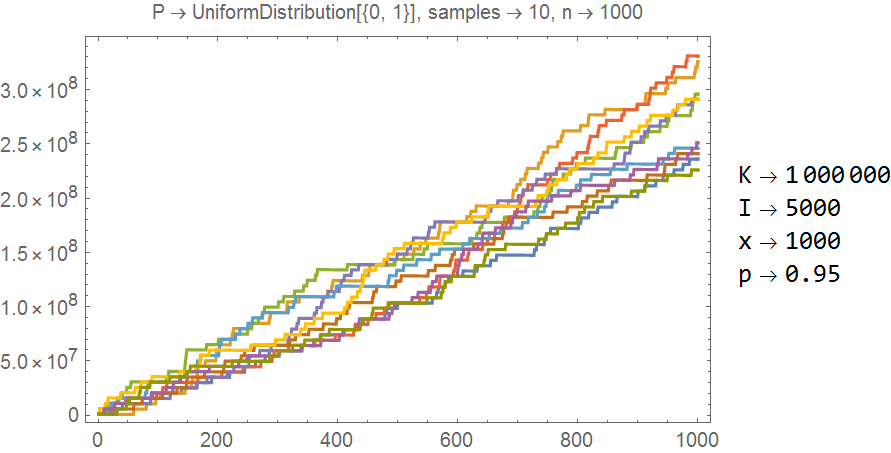In what follows, the code provided will return a plot of a (user provided) number of random experiments that implement the concept of the investment lottery in the question; the output is a sequence of the amounts outstanding, after a lottery has been paid for and possible profits have been accrued instead of the sequence of winnings.
Define an auxiliary function that generates appropriate random numbers:
randomSequence[distribution_: UniformDistribution[], repetitions_: 10, observations_: 10^6] :=
RandomVariate[distribution, {repetitions, observations}]
Eg. evaluating randomSequence[NormalDistribution[], 2, 10] will return a $2\times10$ matrix with random numbers from $N(0,1)$.
Define a lottery without using conditionals; make use of the main evaluation loop instead:
(* when rand >= cut-off prob, return a prize *)
lottery[randomValue_, cost_, multiplier_, probability_] /; randomValue >= probability :=
multiplier cost
(* ...otherwise return 0. *)
lottery[__] := 0.
balance represents the amount remaining after committing to participate in an "investment" lottery; so far nothing fancy, but it's possible to modify balance to obtain more "involved" results if needed.
SetAttributes[balance, HoldFirst]
balance[lottery[randomValue_, cost_, multiplier_, probability_], wealth_] :=
wealth - cost + lottery[randomValue, cost, multiplier, probability]
simulation is the main event; it bundles together the simulation results and the display of the results:
SetAttributes[simulation, HoldFirst]
simulation[randomSequence[args___], capital_, investment_, multiplier_, probability_] :=
Module[{series, opts, header, label, legend},
series = FoldList[
balance[lottery[#2, investment, multiplier, probability], #1] &,
capital, #] & /@ randomSequence[args];
header = {"P", "samples", "n"};
label = Row[Riffle[Thread[header -> {args}], ", "]];
legend = Column[Thread[{"K", "I", "x", "p"} -> {capital, investment, multiplier, probability}]];
opts = {
Frame -> True,
FrameLabel -> {{None, None}, {None, label}}};
Legended[ListLinePlot[series, Apply[Sequence][opts]], legend]
]
Evaluating
simulation[randomSequence[UniformDistribution[], 10, 10^3], 10^6, 5 10^3, 10^3, .95]
returns



F=.95; also, is there a chance you meant for the returns in the good case to read1000Iinstead of1000Sor something similar? $\endgroup$